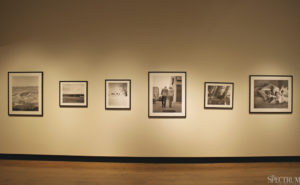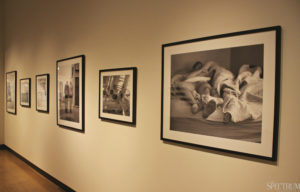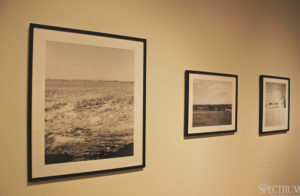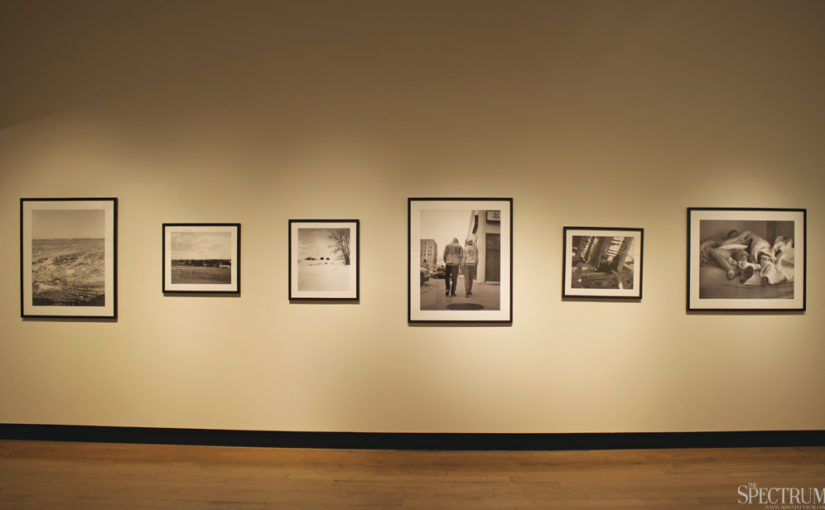
Joshua Barduson’s photography works, as part of the 2017 Spring Baccalaureate Exhibition, go from a remote sense of loneliness to companionship.
Sitting and staring at Joshua Barduson’s works transports you into two different worlds: one of expansive loneliness and another of warm companionship.
Of the six works Barduson chose to feature in this year’s baccalaureate exhibition in the Memorial Union Gallery, three are indistinguishable landscapes and three represent companionship in a state that’s still learning how to accept homosexuality.
Originally from Willmar, Minnesota, Barduson lived in Baltimore, Maryland, and Chicago, Illinois, before moving to Fargo for college. He represents these changes in location through is pieces of photography.
“The overall theme, I guess you could say, is that I really wanted to convey this overwhelming sense of loneliness that I felt when I first moved to North Dakota,” Barduson said.
Barduson’s baccalaureate exhibition is a continuation of his first semester project, something that’s been developing and changing since its conception. Originally, Barduson photographed the bedrooms of gay people in Fargo to show there was “nothing that signified to someone who was looking in that they were gay.”
“My thought process going into that was I wanted it to show that you wouldn’t be able to tell if it was a gay person’s bedroom or a straight person’s bedroom, it’s all the same kind of bedroom,” he said. “But I found that I kept wanting to give these people this voice, but then I realized it’s not my place to give these people a voice. I have to tell my story and then hope that my story resonates and gives enough courage that these people are willing to — not necessarily follow in my footsteps but maybe get the courage to finally start accepting, even to themselves, that this is a part of them and that it’s going to be okay.”
Influences of his original project can still be found in his final presentation, especially when it comes to normalizing being gay.

Barduson’s project started last semester, when he photographed gay people’s bedrooms. He expanded on that story, trying to give voice to his own experience being a gay person in North Dakota.
“I think my main goal was just showing people that gay people exist amongst them and that we’re just like everyone else,” Barduson said. “There’s nothing different to what we do, other than that we’re doing something with the same gender. The hand holding in public, you see that all the time, and no one thinks differently of it if it’s a straight couple. So why are we thinking anything different if it’s a gay couple?”
The inspiration for the project comes from Barduson’s experience in North Dakota. Despite the overwhelming attitude that “nothing could ever happen in Fargo,” Barduson explained that he does experience hate and discomfort.
“(I)t gets hard because you don’t know if you’re getting stared at because they don’t know or if they’re staring at you because they want to hurt you,” he said. “You never really know. And I think that in Fargo especially, there’s this idea that everyone’s really accepting and everyone’s really nice. ‘That wouldn’t happen here’ is what I’ve been hearing a lot of. Unfortunately, it does happen quite a bit here. ”
He was also greatly inspired by LGBT history, especially in relation to art. For many artists throughout history, they needed to hide their sexuality in order to protect themselves and their work. Not only that, but Barduson really wanted to give something back to the people who made it possible for him to be so open about his homosexuality.
“I wanted to make an impact but also pay homage to all these people who have done things in order to let me do this,” he said, “because without them I wouldn’t have been able to be as outwardly spoken. So, I really feel like the best way to pay homage to these people is to be outwardly spoken and loud.”
While his pieces are all focused around North Dakota and Fargo, Barduson needed to travel west for many of his photos in order to capture his own feelings of loneliness and to separate the viewer from a highly recognizable place.
As he continued to drive further west, Barduson explained that the towns he passed through became indistinguishable. Usually, as he was driving, he’d see a location he thought captured his idea and he would pull over and take a picture of it.
Using black and white rather than color, Barduson also wanted to create a sense of something unfinished.

The remote landscapes Barduson photographed don’t really have locations. Barduson just kept driving west, photographing scenes he thought would fit his project.
“I really wanted people to see there’s this completion, this resolution within the series — we go from this depression to this companionship and love and everything — but we’re not quite there yet, we’re not 100 percent all the way there,” he explained. “By leaving it in black and white, not everything is done. For me, once everything’s in color, this is the finished product … Across the United States, there’s a lot of people who think that now that gay marriage is passed, all of our problems are gone. That’s very far from the truth. There’s still quite a bit that has to be done for people to be truly equal. In order to keep it true to that statement, I needed to keep it in black and white.”
After graduation, Barduson hopes to open or be part of an LGBT center that focuses on children and art. By creating a visibility for gay people and a safe space for them to gather, Barduson hopes to make the coming out process easier for some people and to give others a place to feel community.
“When I was younger, I used to be really scared of gay people,” Barduson said. “I didn’t really understand them. I didn’t really get exposed to them. And I really feel like if I had been exposed to them at a younger age my coming out process would have been a lot easier. So I really feel like that’s something that needs to be reinforced from a young age.”
Barduson’s works, in addition to the other baccalaureate students’ works, will be on display through today, April 27. To view more of Barduson’s works, visit his website, jbarduson.com.
